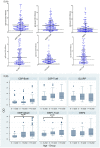Genetic diversity and antibody responses against Plasmodium falciparum vaccine candidate genes from Chhattisgarh, Central India: Implication for vaccine development
- PMID: 28787005
- PMCID: PMC5546615
- DOI: 10.1371/journal.pone.0182674
Genetic diversity and antibody responses against Plasmodium falciparum vaccine candidate genes from Chhattisgarh, Central India: Implication for vaccine development
Abstract
The genetic diversity in Plasmodium falciparum antigens is a major hurdle in developing an effective malaria vaccine. Protective efficacy of the vaccine is dependent on the polymorphic alleles of the vaccine candidate antigens. Therefore, we investigated the genetic diversity of the potential vaccine candidate antigens i.e. msp-1, msp-2, glurp, csp and pfs25 from field isolates of P.falciparum and determined the natural immune response against the synthetic peptide of these antigens. Genotyping was performed using Sanger method and size of alleles, multiplicity of infection, heterogeneity and recombination rate were analyzed. Asexual stage antigens were highly polymorphic with 55 and 50 unique alleles in msp-1 and msp-2 genes, respectively. The MOI for msp-1 and msp-2 were 1.67 and 1.28 respectively. A total 59 genotype was found in glurp gene with 8 types of amino acid repeats in the conserved part of RII repeat region. The number of NANP repeats from 40 to 44 was found among 55% samples in csp gene while pfs25 was found almost conserved with only two amino acid substitution site. The level of genetic diversity in the present study population was very similar to that from Asian countries. A higher IgG response was found in the B-cell epitopes of msp-1 and csp antigens and higher level of antibodies against csp B-cell epitope and glurp antigen were recorded with increasing age groups. Significantly, higher positive responses were observed in the csp antigen among the samples with ≥42 NANP repeats. The present finding showed extensive diversity in the asexual stage antigens.
Conflict of interest statement
Figures





Similar articles
-
Natural antibody responses to Plasmodium falciparum MSP3 and GLURP(R0) antigens are associated with low parasite densities in malaria patients living in the Central Region of Ghana.Parasit Vectors. 2017 Aug 23;10(1):395. doi: 10.1186/s13071-017-2338-7. Parasit Vectors. 2017. PMID: 28835262 Free PMC article.
-
Differential antibody recognition of four allelic variants of the merozoite surface protein-2 (MSP-2) of Plasmodium falciparum.J Eukaryot Microbiol. 2001 Sep-Oct;48(5):556-64. doi: 10.1111/j.1550-7408.2001.tb00191.x. J Eukaryot Microbiol. 2001. PMID: 11596920
-
Genetic polymorphism in msp-2, ama-1 and csp genes in Plasmodium falciparum field isolates from north and north-western India.J Vector Borne Dis. 2009 Jun;46(2):109-16. J Vector Borne Dis. 2009. PMID: 19502690
-
Antibody Correlates of Protection from Clinical Plasmodium falciparum Malaria in an Area of Low and Unstable Malaria Transmission.Am J Trop Med Hyg. 2020 Dec;103(6):2174-2182. doi: 10.4269/ajtmh.18-0805. Epub 2020 Oct 27. Am J Trop Med Hyg. 2020. PMID: 33124533 Free PMC article. Review.
-
Genetic polymorphism in Plasmodium falciparum vaccine candidate antigens.Indian J Pathol Microbiol. 2005 Oct;48(4):429-38. Indian J Pathol Microbiol. 2005. PMID: 16366089 Review.
Cited by
-
Diversity analysis of MSP1 identifies conserved epitope organization in block 2 amidst high sequence variability in Indian Plasmodium falciparum isolates.Malar J. 2018 Dec 3;17(1):447. doi: 10.1186/s12936-018-2592-y. Malar J. 2018. PMID: 30509263 Free PMC article.
-
Genetic polymorphisms of Plasmodium falciparum isolates from Melka-Werer, North East Ethiopia based on the merozoite surface protein-2 (msp-2) gene as a molecular marker.Malar J. 2021 Feb 12;20(1):85. doi: 10.1186/s12936-021-03625-1. Malar J. 2021. PMID: 33579293 Free PMC article.
-
Plasmodium vivax AMA1: Implications of distinct haplotypes for immune response.PLoS Negl Trop Dis. 2020 Jul 8;14(7):e0008471. doi: 10.1371/journal.pntd.0008471. eCollection 2020 Jul. PLoS Negl Trop Dis. 2020. PMID: 32639964 Free PMC article.
-
Genetic sequence characterization and naturally acquired immune response to Plasmodium vivax Rhoptry Neck Protein 2 (PvRON2).Malar J. 2018 Oct 31;17(1):401. doi: 10.1186/s12936-018-2543-7. Malar J. 2018. PMID: 30382855 Free PMC article.
-
Plasmodium falciparum genetic diversity and multiplicity of infection based on msp-1, msp-2, glurp and microsatellite genetic markers in sub-Saharan Africa: a systematic review and meta-analysis.Malar J. 2024 Apr 8;23(1):97. doi: 10.1186/s12936-024-04925-y. Malar J. 2024. PMID: 38589874 Free PMC article.
References
-
- World Malaria Report 2015. World Health Organization, Geneva. 2015. http://www.who.int/malaria/publications/world-malaria-report-2015/report...
-
- Malaria situation in India. NVDCP. http://www.nvbdcp.gov.in/Doc/malaria-situation-Oct16.pdf
-
- Krishna S, Bharti PK, Chandel HS, Ahmad A, Kumar R, Singh PP, et al. Detection of Mixed Infections with Plasmodium spp. by PCR, India, 2014. Emerg Infect Dis. 2015;21:1853–1857. doi: 10.3201/eid2110.150678 - DOI - PMC - PubMed
-
- Crompton PD, Pierce SK, Miller LH. Advances and challenges in malaria vaccine development. J Clin Invest. 2010;120:4168–4178. doi: 10.1172/JCI44423 - DOI - PMC - PubMed
MeSH terms
Substances
LinkOut - more resources
Full Text Sources
Other Literature Sources
Research Materials

